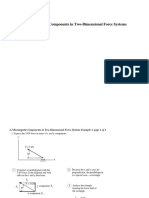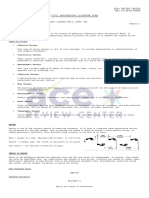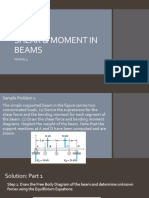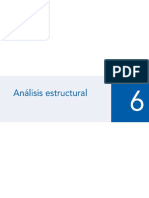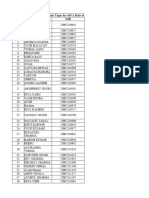1thermal Stresses - 16 Maret 2021
1thermal Stresses - 16 Maret 2021
Uploaded by
Ginanjar Hadi SukmaCopyright:
Available Formats
1thermal Stresses - 16 Maret 2021
1thermal Stresses - 16 Maret 2021
Uploaded by
Ginanjar Hadi SukmaOriginal Title
Copyright
Available Formats
Share this document
Did you find this document useful?
Is this content inappropriate?
Copyright:
Available Formats
1thermal Stresses - 16 Maret 2021
1thermal Stresses - 16 Maret 2021
Uploaded by
Ginanjar Hadi SukmaCopyright:
Available Formats
Edition
Third
MECHANICS OF MATERIALS Beer • Johnston • DeWolf
Thermal Stresses
• A temperature change results in a change in length or
thermal strain. There is no stress associated with the
thermal strain unless the elongation is restrained by
the supports.
• Treat the additional support as redundant and apply
the principle of superposition.
PL
T = (T )L P =
AE
= thermal expansion coef.
• The thermal deformation and the deformation from
the redundant support must be compatible.
= T + P = 0 = T + P = 0
P = − AE (T )
PL
(T )L + =0 P
AE = = − E (T )
A
© 2002 The McGraw-Hill Companies, Inc. All rights reserved. 2 - 21
Edition
Third
MECHANICS OF MATERIALS Beer • Johnston • DeWolf
Poisson’s Ratio
• For a slender bar subjected to axial loading:
x = x y =z = 0
E
• The elongation in the x-direction is
accompanied by a contraction in the other
directions. Assuming that the material is
isotropic (no directional dependence),
y = z 0
• Poisson’s ratio is defined as
lateral strain y
n= =− =− z
axial strain x x
© 2002 The McGraw-Hill Companies, Inc. All rights reserved. 2 - 22
Edition
Third
MECHANICS OF MATERIALS Beer • Johnston • DeWolf
Generalized Hooke’s Law
• For an element subjected to multi-axial loading,
the normal strain components resulting from the
stress components may be determined from the
principle of superposition. This requires:
1) strain is linearly related to stress
2) deformations are small
• With these restrictions:
x n y n z
x = + − −
E E E
n x y n z
y = − + −
E E E
n x n y z
z = − − +
E E E
© 2002 The McGraw-Hill Companies, Inc. All rights reserved. 2 - 23
Edition
Third
MECHANICS OF MATERIALS Beer • Johnston • DeWolf
Dilatation: Bulk Modulus
• Relative to the unstressed state, the change in volume is
( )
e = 1 − (1 + x ) 1 + y (1 + z ) = 1 − 1 + x + y + z
= x + y +z
1 − 2n
=
E
(
x + y + z )
= dilatation (change in volume per unit volume)
• For element subjected to uniform hydrostatic pressure,
3(1 − 2n ) p
e = −p =−
E k
E
k= = bulk modulus
3(1 − 2n )
• Subjected to uniform pressure, dilatation must be
negative, therefore
0 n 12
© 2002 The McGraw-Hill Companies, Inc. All rights reserved.
Edition
Third
MECHANICS OF MATERIALS Beer • Johnston • DeWolf
Shearing Strain
• A cubic element subjected to a shear stress will
deform into a rhomboid. The corresponding shear
strain is quantified in terms of the change in angle
between the sides,
xy = f ( xy )
• A plot of shear stress vs. shear strain is similar the
previous plots of normal stress vs. normal strain
except that the strength values are approximately
half. For small strains,
xy = G xy yz = G yz zx = G zx
where G is the modulus of rigidity or shear modulus.
© 2002 The McGraw-Hill Companies, Inc. All rights reserved. 2 - 25
Edition
Third
MECHANICS OF MATERIALS Beer • Johnston • DeWolf
Example 2.10
SOLUTION:
• Determine the average angular
deformation or shearing strain of
the block.
• Apply Hooke’s law for shearing stress
and strain to find the corresponding
shearing stress.
A rectangular block of material with
modulus of rigidity G = 90 ksi is • Use the definition of shearing stress to
bonded to two rigid horizontal plates. find the force P.
The lower plate is fixed, while the
upper plate is subjected to a horizontal
force P. Knowing that the upper plate
moves through 0.04 in. under the action
of the force, determine a) the average
shearing strain in the material, and b)
the force P exerted on the plate.
© 2002 The McGraw-Hill Companies, Inc. All rights reserved. 2 - 26
Edition
Third
MECHANICS OF MATERIALS Beer • Johnston • DeWolf
• Determine the average angular deformation
or shearing strain of the block.
0.04 in.
xy tan xy = xy = 0.020 rad
2 in.
• Apply Hooke’s law for shearing stress and
strain to find the corresponding shearing
stress.
( )
xy = G xy = 90 103 psi (0.020 rad ) = 1800 psi
• Use the definition of shearing stress to find
the force P.
P = xy A = (1800 psi )(8 in. )(2.5 in. ) = 36 103 lb
P = 36.0 kips
© 2002 The McGraw-Hill Companies, Inc. All rights reserved. 2 - 27
Edition
Third
MECHANICS OF MATERIALS Beer • Johnston • DeWolf
Relation Among E, n, and G
• An axially loaded slender bar will
elongate in the axial direction and
contract in the transverse directions.
• An initially cubic element oriented as in
top figure will deform into a rectangular
parallelepiped. The axial load produces a
normal strain.
• If the cubic element is oriented as in the
bottom figure, it will deform into a
rhombus. Axial load also results in a shear
strain.
• Components of normal and shear strain are
related,
E
= (1 + n )
2G
© 2002 The McGraw-Hill Companies, Inc. All rights reserved. 2 - 28
Edition
Third
MECHANICS OF MATERIALS Beer • Johnston • DeWolf
Sample Problem 2.5
A circle of diameter d = 9 in. is scribed on an
unstressed aluminum plate of thickness t = 3/4
in. Forces acting in the plane of the plate later
cause normal stresses x = 12 ksi and z = 20
ksi.
For E = 10x106 psi and n = 1/3, determine the
change in:
a) the length of diameter AB,
b) the length of diameter CD,
c) the thickness of the plate, and
d) the volume of the plate.
© 2002 The McGraw-Hill Companies, Inc. All rights reserved. 2 - 29
Edition
Third
MECHANICS OF MATERIALS Beer • Johnston • DeWolf
SOLUTION:
• Apply the generalized Hooke’s Law to • Evaluate the deformation components.
find the three components of normal
strain.
(
B A = x d = + 0.533 10 −3 in./in. (9 in. ) )
x n y n z B A = +4.8 10 −3 in.
x = + − −
E E E
C D ( )
= z d = + 1.600 10 −3 in./in. (9 in. )
1 1
= (12 ksi ) − 0 − (20 ksi )
10 106 psi 3 C D = +14.4 10 −3 in.
= +0.533 10 −3 in./in. ( )
t = y t = − 1.067 10 −3 in./in. (0.75 in. )
n x y n z t = −0.800 10 −3 in.
y = − + −
E E E
= −1.067 10 −3 in./in.
• Find the change in volume
n x n y
z = − − + z e = x + y + z = 1.067 10 −3 in 3/in 3
E E E
= +1.600 10 −3 in./in. V = eV = 1.067 10 −3 (15 15 0.75 )in 3
V = +0.187 in 3
© 2002 The McGraw-Hill Companies, Inc. All rights reserved. 2 - 30
You might also like
- Gee 141 Module 2Document12 pagesGee 141 Module 2mojahidrascal269No ratings yet
- M01 Hibb0000 00 Se C16Document153 pagesM01 Hibb0000 00 Se C16luisloredoperez156No ratings yet
- Ul 2024 2011Document40 pagesUl 2024 2011cudalb georgeNo ratings yet
- CE Board Nov 2020 Engineering Mechanics Set 1Document3 pagesCE Board Nov 2020 Engineering Mechanics Set 1Eugenio Genesis AbadNo ratings yet
- Chapter 4. Equilibrium of Non Concurrent Force SystemsDocument7 pagesChapter 4. Equilibrium of Non Concurrent Force SystemscarminavegamariaNo ratings yet
- Civl3411 Tutorial 1 Solution Soil Stresses and StrainsDocument8 pagesCivl3411 Tutorial 1 Solution Soil Stresses and Strainss041865No ratings yet
- Chapter 1Document12 pagesChapter 1Lester Neil LomodNo ratings yet
- Transportation Engineering PDF FreeDocument13 pagesTransportation Engineering PDF FreeDenise DimayaNo ratings yet
- 5.shear Strength of SoilDocument25 pages5.shear Strength of SoilGladys LeonorNo ratings yet
- Moments 2Document62 pagesMoments 2CharlesNo ratings yet
- N 0 T 0 M I M and Iare Taken With Respect To A CentroidalDocument6 pagesN 0 T 0 M I M and Iare Taken With Respect To A CentroidalRetro GamerNo ratings yet
- Engineering Mechanics and Strength of MaterialsDocument9 pagesEngineering Mechanics and Strength of MaterialsscarlettNo ratings yet
- Solution of Statics - Assignment 8Document8 pagesSolution of Statics - Assignment 8Omar NabilNo ratings yet
- CM 6 Ceemec30Document32 pagesCM 6 Ceemec30enel eneruNo ratings yet
- Chapter 6-Dynamics-Kinematics-KineticsDocument36 pagesChapter 6-Dynamics-Kinematics-KineticsO.SNo ratings yet
- Review SessionDocument52 pagesReview SessionEskat Torres FaderonNo ratings yet
- FE FINALS Set ADocument2 pagesFE FINALS Set APau SusperNo ratings yet
- Fluids PDF Part 3Document22 pagesFluids PDF Part 3DELOS SANTOS GERALDNo ratings yet
- Strength of Materials Chapter 8Document22 pagesStrength of Materials Chapter 8ANTILA JASMINENo ratings yet
- Eas254 - SDM Part 2 - ExamplesDocument15 pagesEas254 - SDM Part 2 - ExamplesNasrulNo ratings yet
- May 2022 Ce Board Exam Alvarez 4: Eview NnovationsDocument3 pagesMay 2022 Ce Board Exam Alvarez 4: Eview NnovationsKian InductivoNo ratings yet
- MEGA Review-Module-32-Strength-of-Materials-3Document1 pageMEGA Review-Module-32-Strength-of-Materials-3Study BuddiesNo ratings yet
- MotionDocument19 pagesMotionKevin CalpitoNo ratings yet
- Note 4Document5 pagesNote 4Mohamaad100% (1)
- Moments MechanicsDocument173 pagesMoments MechanicsChicha WatersNo ratings yet
- Lesson 3 Direction of Lines, Interior and Deflection Angles, Etc.Document8 pagesLesson 3 Direction of Lines, Interior and Deflection Angles, Etc.Prince Eduard ManucumNo ratings yet
- MG1 - L7 - C.7 - PDFedDocument27 pagesMG1 - L7 - C.7 - PDFedBreno PalluNo ratings yet
- Chapter IV Shear and Moment in Beams 4.4Document6 pagesChapter IV Shear and Moment in Beams 4.4Joshua John JulioNo ratings yet
- Chapter 12Document8 pagesChapter 12이희인No ratings yet
- GEO 2 LectureDocument37 pagesGEO 2 LecturePin YNo ratings yet
- Probability, Surveyng, Transpotation EngringDocument13 pagesProbability, Surveyng, Transpotation EngringCaro Kan LopezNo ratings yet
- Rect Comp 2dDocument39 pagesRect Comp 2dLin Xian XingNo ratings yet
- Problem Set No. 5Document10 pagesProblem Set No. 5Carl Malone TolentinoNo ratings yet
- Quiz 1 1Document2 pagesQuiz 1 1Kapukets GreyNo ratings yet
- Torsion Sample Problem 2Document9 pagesTorsion Sample Problem 2Richiel Pasilan LañohanNo ratings yet
- Mathcad Defining Evaluating FunctionsDocument3 pagesMathcad Defining Evaluating FunctionsKim AceoNo ratings yet
- 112Document10 pages112Memo LyNo ratings yet
- Topic 2 - Miscellaneous Points On The Simple CurveDocument4 pagesTopic 2 - Miscellaneous Points On The Simple CurveNicholas Bonn SingNo ratings yet
- CE Module 11 - Surveying (Principles)Document9 pagesCE Module 11 - Surveying (Principles)Angelice Alliah De la CruzNo ratings yet
- MCQs in Engineering Mathematics Part 10Document12 pagesMCQs in Engineering Mathematics Part 10Richster LofrancoNo ratings yet
- Cabauatan Jericho PDFDocument3 pagesCabauatan Jericho PDFcalliemozartNo ratings yet
- CIE 128 - Lesson 8-9Document11 pagesCIE 128 - Lesson 8-9Daniel ColladoNo ratings yet
- Chapter 3 - Statics of Rigid BodyDocument61 pagesChapter 3 - Statics of Rigid BodyMUHAMMAD AQIM MOHD SUHAIMINo ratings yet
- Solution PRELIM STHEORY 2020-2021 PDFDocument22 pagesSolution PRELIM STHEORY 2020-2021 PDFErick MangalinoNo ratings yet
- Week 6 - Module 5 (March 2024 Refresher)Document99 pagesWeek 6 - Module 5 (March 2024 Refresher)John Dave GargantaNo ratings yet
- Lesson 16 Stress Transformation (Mohr Circle)Document4 pagesLesson 16 Stress Transformation (Mohr Circle)Joshua John JulioNo ratings yet
- Quiz Finals Arrange With SolDocument3 pagesQuiz Finals Arrange With SolBea MaglalangNo ratings yet
- Engg MechanicsDocument31 pagesEngg MechanicsMuzahid IslamNo ratings yet
- Littons Problematical RecreationsDocument9 pagesLittons Problematical RecreationsjitlcompanyNo ratings yet
- BrasdaDocument3 pagesBrasdaJayson Brylle MojaresNo ratings yet
- Module 4 Shear and Moment Diagram Part 2Document30 pagesModule 4 Shear and Moment Diagram Part 2FLORENCE BANIAGANo ratings yet
- Chapter 6 NodosDocument35 pagesChapter 6 NodosMaria Alejandra ObandoNo ratings yet
- 7 Trapezoidal Combined FootingDocument9 pages7 Trapezoidal Combined FootingMark Angelo FloresNo ratings yet
- Civil Engineering Board Exam ReviewDocument1 pageCivil Engineering Board Exam ReviewBryan James Bigstone LadaranNo ratings yet
- CMT Lesson 2Document14 pagesCMT Lesson 2April Jhen BenavidezNo ratings yet
- Friction Problem AnalysisDocument9 pagesFriction Problem AnalysisScott AlilayNo ratings yet
- Mechanics 1Document2 pagesMechanics 1Eunice FiecasNo ratings yet
- Chapter 2 2-002 (Basis)Document2 pagesChapter 2 2-002 (Basis)Jamiel CatapangNo ratings yet
- Mechanics-2 2 Axial LoadingDocument22 pagesMechanics-2 2 Axial LoadingMuhd NizammudinNo ratings yet
- Green's Function Estimates for Lattice Schrödinger Operators and ApplicationsFrom EverandGreen's Function Estimates for Lattice Schrödinger Operators and ApplicationsNo ratings yet
- Homework No 4: ECIV 524: Structural Vibrations January 2023Document2 pagesHomework No 4: ECIV 524: Structural Vibrations January 2023Mamdud MithuNo ratings yet
- Angle of Deppression and ElevationDocument2 pagesAngle of Deppression and ElevationJuvie MarquezNo ratings yet
- A Seminar On: Paper Cutting Machine Using Geneva MechanismDocument9 pagesA Seminar On: Paper Cutting Machine Using Geneva MechanismSantosh SuryavanshiNo ratings yet
- Thomas Greenspan-Stability of Lagrange PointsDocument9 pagesThomas Greenspan-Stability of Lagrange PointsVĩ AoNo ratings yet
- Material Test Certificate: M/s Alstom Projects India LimitedDocument1 pageMaterial Test Certificate: M/s Alstom Projects India LimitedDeepak HoleNo ratings yet
- Mat 052 Cfe ReviewerDocument11 pagesMat 052 Cfe ReviewerKen EuphroNo ratings yet
- Coupling BeamDocument3 pagesCoupling BeamMustafa ZahidNo ratings yet
- IM For DC MachineDocument25 pagesIM For DC MachineAraiza FloresNo ratings yet
- 3.2 Joint Probability Density Functions: (JPDF) - For Example The JPDF PDocument1 page3.2 Joint Probability Density Functions: (JPDF) - For Example The JPDF P224883061No ratings yet
- Mind Mapping 9 Satria Krisnanda PDFDocument1 pageMind Mapping 9 Satria Krisnanda PDFMade Satria Krisnanda PujawanNo ratings yet
- Behavior of Gravity Load Designed Reinforced Concrete Buildings Subjected To EarthquakesDocument13 pagesBehavior of Gravity Load Designed Reinforced Concrete Buildings Subjected To EarthquakesMarimuthu KaliyamoorthyNo ratings yet
- Ch8 - Rotational MotionDocument40 pagesCh8 - Rotational MotionGhazi DallyNo ratings yet
- Tapology Front PageDocument5 pagesTapology Front Pagesiddiqui.sufiyan313No ratings yet
- 3.3 Active and Passive VoiceDocument1 page3.3 Active and Passive Voicetessa mariaNo ratings yet
- Full Download (Ebook PDF) Conceptual Physical Science 6th Edition PDFDocument51 pagesFull Download (Ebook PDF) Conceptual Physical Science 6th Edition PDFhotarudjony100% (4)
- Phoebus J. Dhrymes (Auth.) - Introductory Econometrics-Springer-Verlag New York (1978) PDFDocument435 pagesPhoebus J. Dhrymes (Auth.) - Introductory Econometrics-Springer-Verlag New York (1978) PDFMelissa OrozcoNo ratings yet
- Heat Transfer and Solid Mechanics With A CantileverDocument9 pagesHeat Transfer and Solid Mechanics With A CantileverMaruda8382No ratings yet
- Reynolds Transport TheoremDocument21 pagesReynolds Transport TheoremMae BacurioNo ratings yet
- Physich KhamaluddinDocument5 pagesPhysich KhamaluddinNur Lailatul QodriyahNo ratings yet
- Case Study Topics For Engineering PhysicsDocument4 pagesCase Study Topics For Engineering Physicshng1businessNo ratings yet
- 10 1109@ted 2023 3273513Document9 pages10 1109@ted 2023 3273513Nima SalianiNo ratings yet
- Chapter-One: Signal and Systems 1. SignalsDocument437 pagesChapter-One: Signal and Systems 1. SignalsayadmanNo ratings yet
- JoSAA Seat MatrixDocument90 pagesJoSAA Seat Matrixjithendra koletiNo ratings yet
- EV2 - 93-100 To 94-000Document2 pagesEV2 - 93-100 To 94-000ajorbind.12No ratings yet
- Vibration Analysis of An Induction MotorDocument25 pagesVibration Analysis of An Induction MotorSanthosh KumarNo ratings yet
- Test Bank For College Physics 9th Edition YoungDocument10 pagesTest Bank For College Physics 9th Edition YounglouisadonaldlwrNo ratings yet
- Department of Civil Engineering Lab Manual OF Structural Analysis-Ii (Ece-305)Document30 pagesDepartment of Civil Engineering Lab Manual OF Structural Analysis-Ii (Ece-305)doktorterNo ratings yet
- Lecture 8: Momentum, Impulse, and CollisionsDocument5 pagesLecture 8: Momentum, Impulse, and Collisionsjenny sorbetNo ratings yet
- Machine Elements Mechanical Engineering Design (Bag.3)Document41 pagesMachine Elements Mechanical Engineering Design (Bag.3)AchmadNo ratings yet































